Impact of CSR Transformation on Construction Companies' Development.
VerifiedAdded on 2023/06/14
|62
|16901
|361
Thesis and Dissertation
AI Summary
This research investigates the current state of Corporate Social Responsibility (CSR) activities and reporting within the construction industry globally, aiming to understand the most relevant CSR areas for this sector and the influence of CSR agendas on organizational activities. It addresses the limited availability of information on CSR in construction, despite the industry's significant environmental and social impact. The study seeks to provide suggestions for improving CSR practices in the construction industry to enhance business activities. It employs a methodology to gather data from various sources, creating a comprehensive view of organizational performance and identifying potential areas for development. The research includes a review of existing literature, data analysis using quantitative and qualitative methods, and concludes with an overview of results, limitations, and suggestions for further research, ultimately contributing to a better understanding of CSR's role in transforming and developing construction industries.
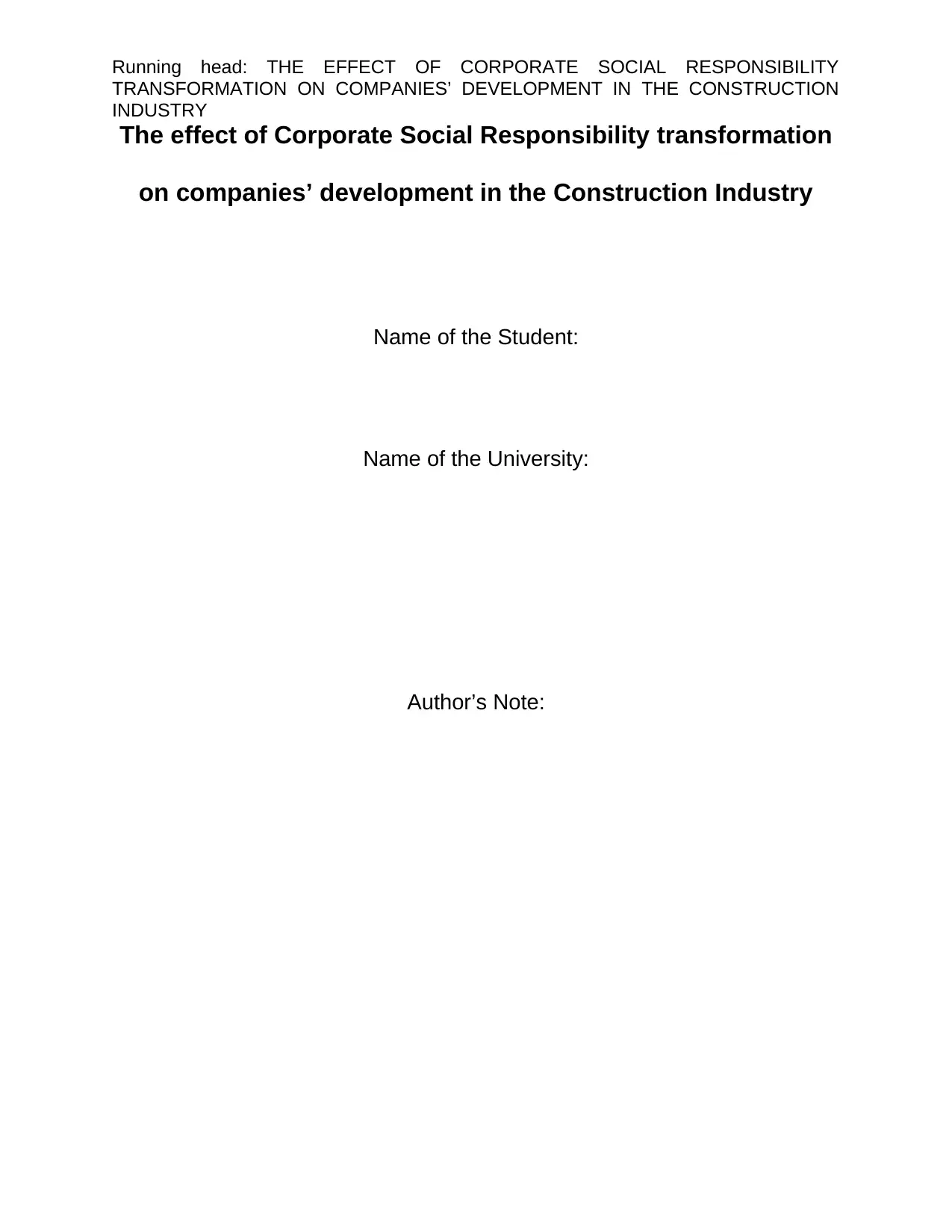
Running head: THE EFFECT OF CORPORATE SOCIAL RESPONSIBILITY
TRANSFORMATION ON COMPANIES’ DEVELOPMENT IN THE CONSTRUCTION
INDUSTRY
The effect of Corporate Social Responsibility transformation
on companies’ development in the Construction Industry
Name of the Student:
Name of the University:
Author’s Note:
TRANSFORMATION ON COMPANIES’ DEVELOPMENT IN THE CONSTRUCTION
INDUSTRY
The effect of Corporate Social Responsibility transformation
on companies’ development in the Construction Industry
Name of the Student:
Name of the University:
Author’s Note:
Paraphrase This Document
Need a fresh take? Get an instant paraphrase of this document with our AI Paraphraser
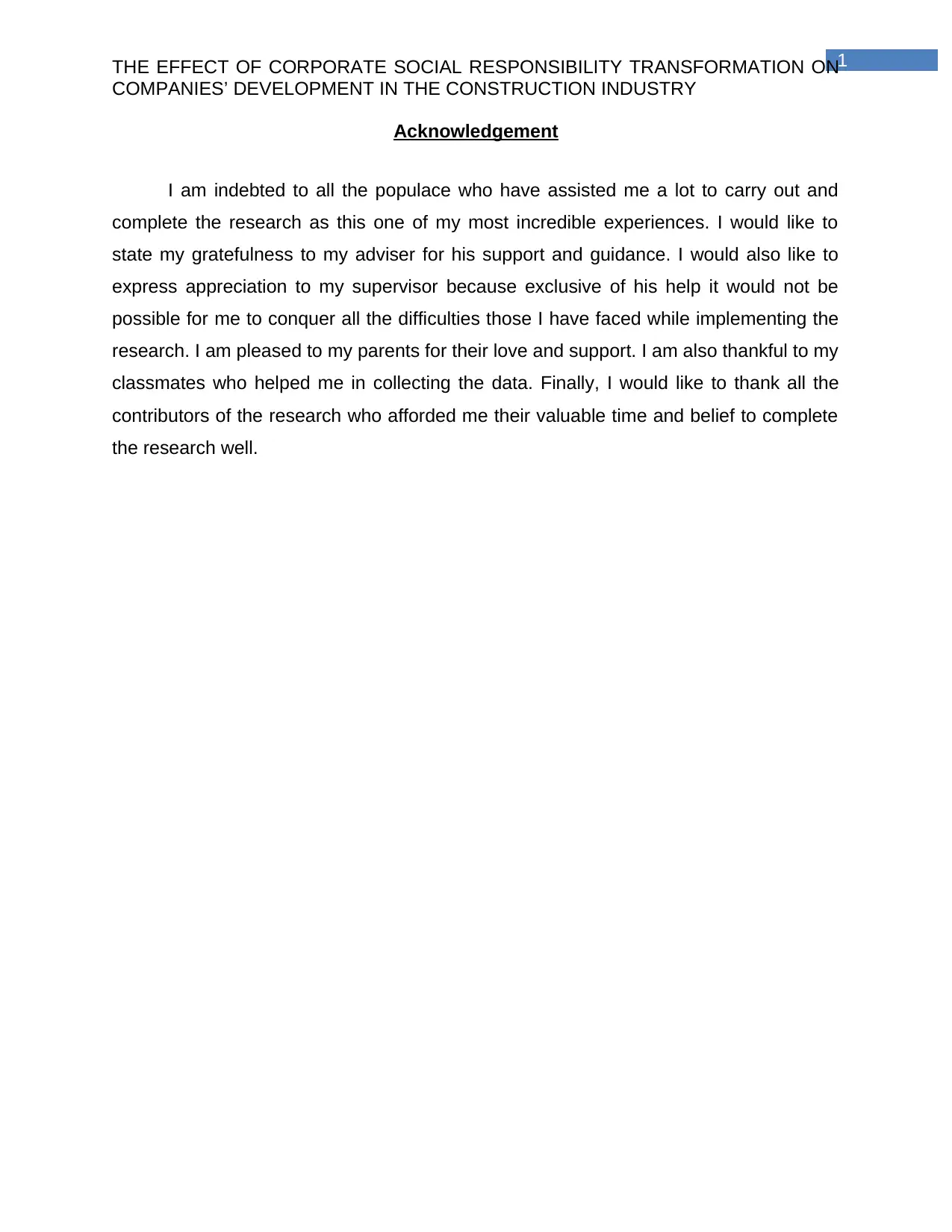
1THE EFFECT OF CORPORATE SOCIAL RESPONSIBILITY TRANSFORMATION ON
COMPANIES’ DEVELOPMENT IN THE CONSTRUCTION INDUSTRY
Acknowledgement
I am indebted to all the populace who have assisted me a lot to carry out and
complete the research as this one of my most incredible experiences. I would like to
state my gratefulness to my adviser for his support and guidance. I would also like to
express appreciation to my supervisor because exclusive of his help it would not be
possible for me to conquer all the difficulties those I have faced while implementing the
research. I am pleased to my parents for their love and support. I am also thankful to my
classmates who helped me in collecting the data. Finally, I would like to thank all the
contributors of the research who afforded me their valuable time and belief to complete
the research well.
COMPANIES’ DEVELOPMENT IN THE CONSTRUCTION INDUSTRY
Acknowledgement
I am indebted to all the populace who have assisted me a lot to carry out and
complete the research as this one of my most incredible experiences. I would like to
state my gratefulness to my adviser for his support and guidance. I would also like to
express appreciation to my supervisor because exclusive of his help it would not be
possible for me to conquer all the difficulties those I have faced while implementing the
research. I am pleased to my parents for their love and support. I am also thankful to my
classmates who helped me in collecting the data. Finally, I would like to thank all the
contributors of the research who afforded me their valuable time and belief to complete
the research well.
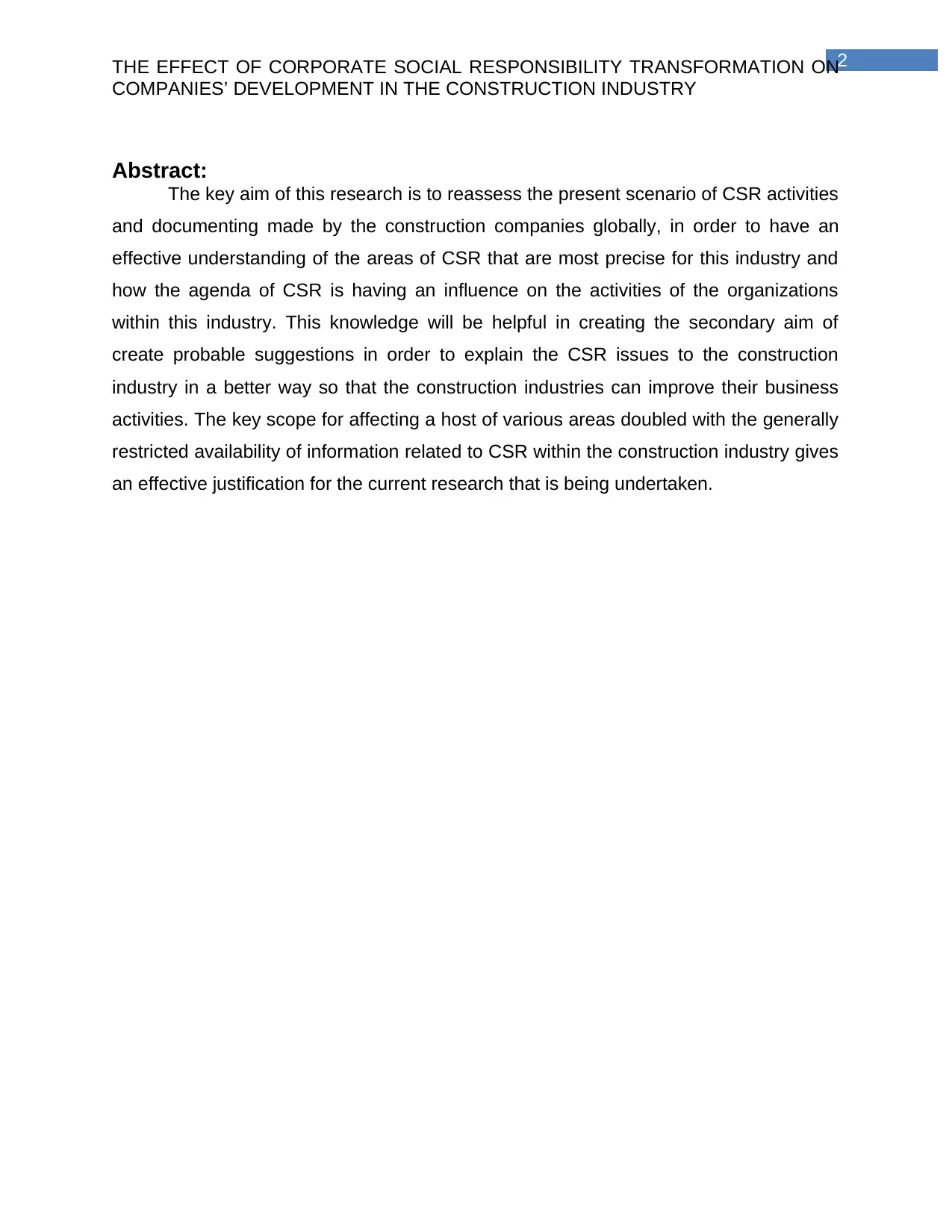
2THE EFFECT OF CORPORATE SOCIAL RESPONSIBILITY TRANSFORMATION ON
COMPANIES’ DEVELOPMENT IN THE CONSTRUCTION INDUSTRY
Abstract:
The key aim of this research is to reassess the present scenario of CSR activities
and documenting made by the construction companies globally, in order to have an
effective understanding of the areas of CSR that are most precise for this industry and
how the agenda of CSR is having an influence on the activities of the organizations
within this industry. This knowledge will be helpful in creating the secondary aim of
create probable suggestions in order to explain the CSR issues to the construction
industry in a better way so that the construction industries can improve their business
activities. The key scope for affecting a host of various areas doubled with the generally
restricted availability of information related to CSR within the construction industry gives
an effective justification for the current research that is being undertaken.
COMPANIES’ DEVELOPMENT IN THE CONSTRUCTION INDUSTRY
Abstract:
The key aim of this research is to reassess the present scenario of CSR activities
and documenting made by the construction companies globally, in order to have an
effective understanding of the areas of CSR that are most precise for this industry and
how the agenda of CSR is having an influence on the activities of the organizations
within this industry. This knowledge will be helpful in creating the secondary aim of
create probable suggestions in order to explain the CSR issues to the construction
industry in a better way so that the construction industries can improve their business
activities. The key scope for affecting a host of various areas doubled with the generally
restricted availability of information related to CSR within the construction industry gives
an effective justification for the current research that is being undertaken.
⊘ This is a preview!⊘
Do you want full access?
Subscribe today to unlock all pages.

Trusted by 1+ million students worldwide
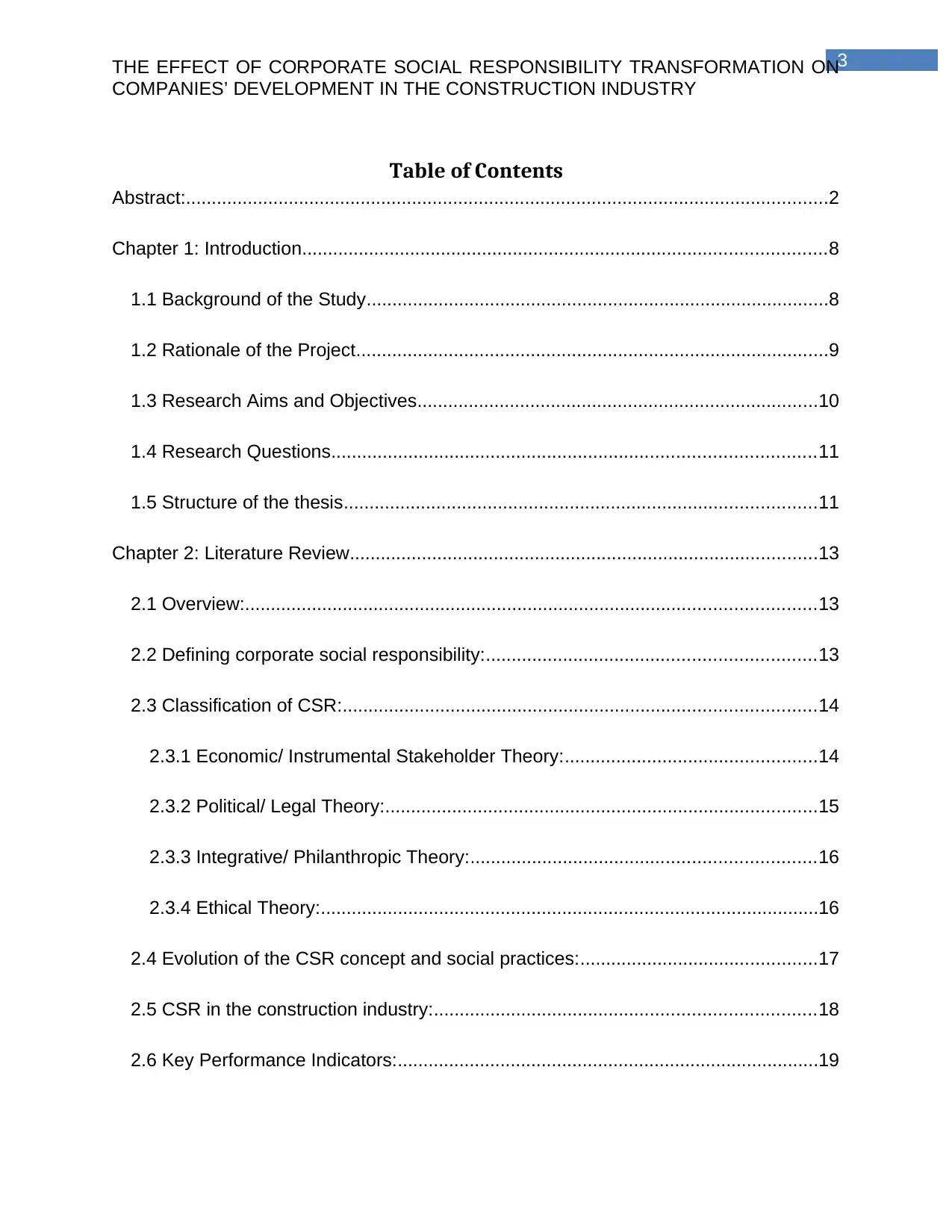
3THE EFFECT OF CORPORATE SOCIAL RESPONSIBILITY TRANSFORMATION ON
COMPANIES’ DEVELOPMENT IN THE CONSTRUCTION INDUSTRY
Table of Contents
Abstract:.............................................................................................................................2
Chapter 1: Introduction......................................................................................................8
1.1 Background of the Study..........................................................................................8
1.2 Rationale of the Project............................................................................................9
1.3 Research Aims and Objectives..............................................................................10
1.4 Research Questions..............................................................................................11
1.5 Structure of the thesis............................................................................................11
Chapter 2: Literature Review...........................................................................................13
2.1 Overview:...............................................................................................................13
2.2 Defining corporate social responsibility:................................................................13
2.3 Classification of CSR:............................................................................................14
2.3.1 Economic/ Instrumental Stakeholder Theory:.................................................14
2.3.2 Political/ Legal Theory:....................................................................................15
2.3.3 Integrative/ Philanthropic Theory:...................................................................16
2.3.4 Ethical Theory:.................................................................................................16
2.4 Evolution of the CSR concept and social practices:..............................................17
2.5 CSR in the construction industry:..........................................................................18
2.6 Key Performance Indicators:..................................................................................19
COMPANIES’ DEVELOPMENT IN THE CONSTRUCTION INDUSTRY
Table of Contents
Abstract:.............................................................................................................................2
Chapter 1: Introduction......................................................................................................8
1.1 Background of the Study..........................................................................................8
1.2 Rationale of the Project............................................................................................9
1.3 Research Aims and Objectives..............................................................................10
1.4 Research Questions..............................................................................................11
1.5 Structure of the thesis............................................................................................11
Chapter 2: Literature Review...........................................................................................13
2.1 Overview:...............................................................................................................13
2.2 Defining corporate social responsibility:................................................................13
2.3 Classification of CSR:............................................................................................14
2.3.1 Economic/ Instrumental Stakeholder Theory:.................................................14
2.3.2 Political/ Legal Theory:....................................................................................15
2.3.3 Integrative/ Philanthropic Theory:...................................................................16
2.3.4 Ethical Theory:.................................................................................................16
2.4 Evolution of the CSR concept and social practices:..............................................17
2.5 CSR in the construction industry:..........................................................................18
2.6 Key Performance Indicators:..................................................................................19
Paraphrase This Document
Need a fresh take? Get an instant paraphrase of this document with our AI Paraphraser
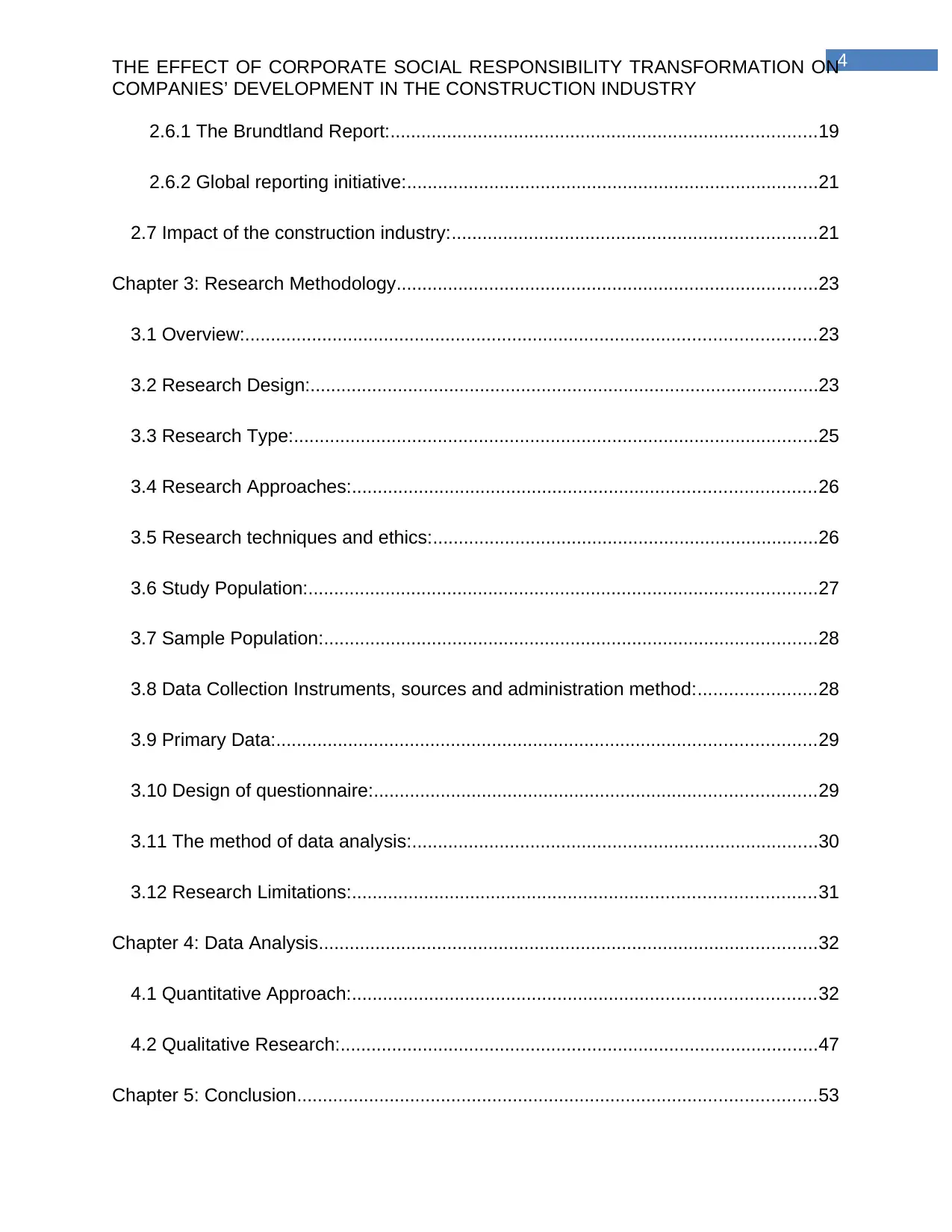
4THE EFFECT OF CORPORATE SOCIAL RESPONSIBILITY TRANSFORMATION ON
COMPANIES’ DEVELOPMENT IN THE CONSTRUCTION INDUSTRY
2.6.1 The Brundtland Report:...................................................................................19
2.6.2 Global reporting initiative:................................................................................21
2.7 Impact of the construction industry:.......................................................................21
Chapter 3: Research Methodology..................................................................................23
3.1 Overview:...............................................................................................................23
3.2 Research Design:...................................................................................................23
3.3 Research Type:......................................................................................................25
3.4 Research Approaches:..........................................................................................26
3.5 Research techniques and ethics:...........................................................................26
3.6 Study Population:...................................................................................................27
3.7 Sample Population:................................................................................................28
3.8 Data Collection Instruments, sources and administration method:.......................28
3.9 Primary Data:.........................................................................................................29
3.10 Design of questionnaire:......................................................................................29
3.11 The method of data analysis:...............................................................................30
3.12 Research Limitations:..........................................................................................31
Chapter 4: Data Analysis.................................................................................................32
4.1 Quantitative Approach:..........................................................................................32
4.2 Qualitative Research:.............................................................................................47
Chapter 5: Conclusion.....................................................................................................53
COMPANIES’ DEVELOPMENT IN THE CONSTRUCTION INDUSTRY
2.6.1 The Brundtland Report:...................................................................................19
2.6.2 Global reporting initiative:................................................................................21
2.7 Impact of the construction industry:.......................................................................21
Chapter 3: Research Methodology..................................................................................23
3.1 Overview:...............................................................................................................23
3.2 Research Design:...................................................................................................23
3.3 Research Type:......................................................................................................25
3.4 Research Approaches:..........................................................................................26
3.5 Research techniques and ethics:...........................................................................26
3.6 Study Population:...................................................................................................27
3.7 Sample Population:................................................................................................28
3.8 Data Collection Instruments, sources and administration method:.......................28
3.9 Primary Data:.........................................................................................................29
3.10 Design of questionnaire:......................................................................................29
3.11 The method of data analysis:...............................................................................30
3.12 Research Limitations:..........................................................................................31
Chapter 4: Data Analysis.................................................................................................32
4.1 Quantitative Approach:..........................................................................................32
4.2 Qualitative Research:.............................................................................................47
Chapter 5: Conclusion.....................................................................................................53

5THE EFFECT OF CORPORATE SOCIAL RESPONSIBILITY TRANSFORMATION ON
COMPANIES’ DEVELOPMENT IN THE CONSTRUCTION INDUSTRY
5.1 Overview of results:...............................................................................................53
5.2 Limitations:.............................................................................................................53
5.3 Scope for further research:....................................................................................54
Reference List..................................................................................................................55
Appendix:.........................................................................................................................59
COMPANIES’ DEVELOPMENT IN THE CONSTRUCTION INDUSTRY
5.1 Overview of results:...............................................................................................53
5.2 Limitations:.............................................................................................................53
5.3 Scope for further research:....................................................................................54
Reference List..................................................................................................................55
Appendix:.........................................................................................................................59
⊘ This is a preview!⊘
Do you want full access?
Subscribe today to unlock all pages.

Trusted by 1+ million students worldwide
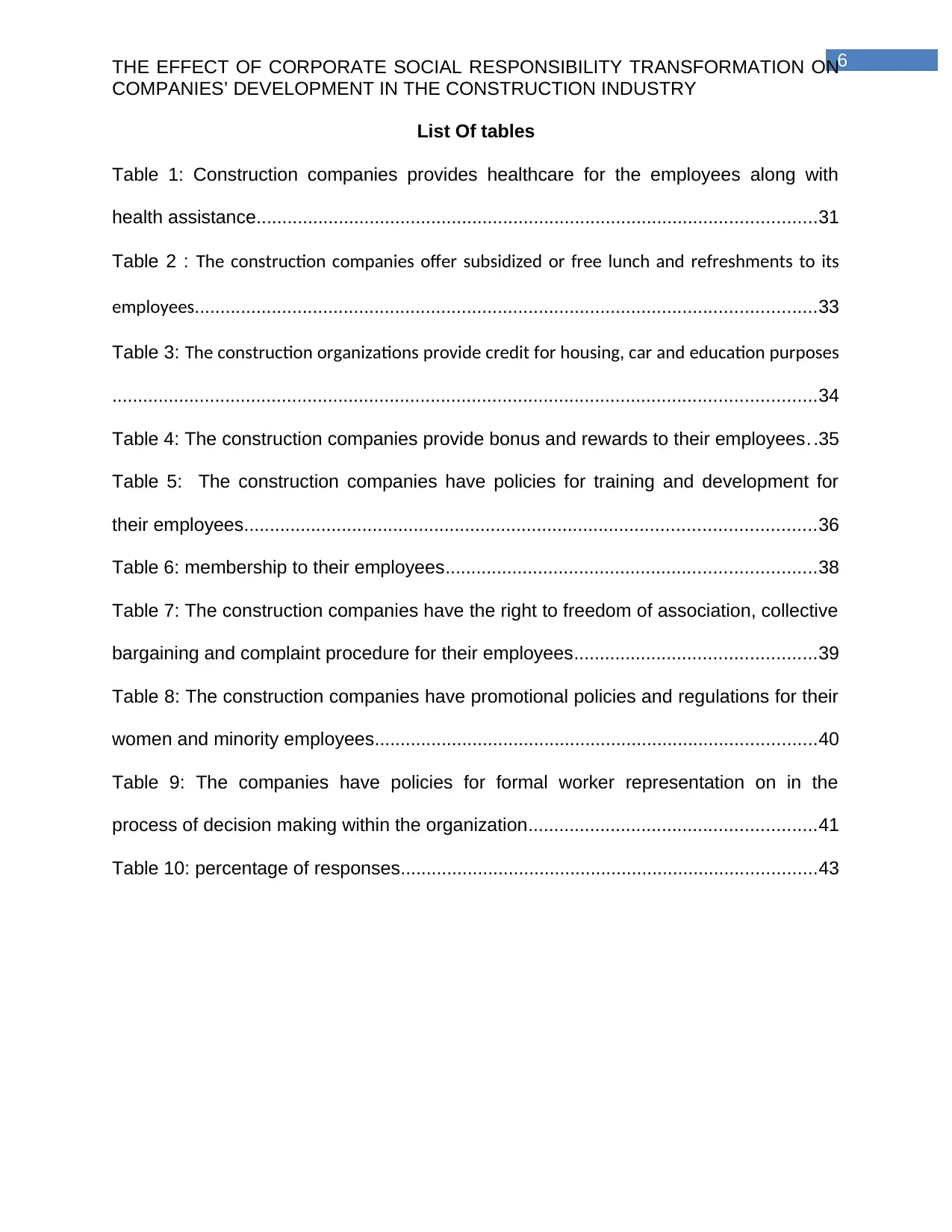
6THE EFFECT OF CORPORATE SOCIAL RESPONSIBILITY TRANSFORMATION ON
COMPANIES’ DEVELOPMENT IN THE CONSTRUCTION INDUSTRY
List Of tables
Table 1: Construction companies provides healthcare for the employees along with
health assistance.............................................................................................................31
Table 2 : The construction companies offer subsidized or free lunch and refreshments to its
employees.........................................................................................................................33
Table 3: The construction organizations provide credit for housing, car and education purposes
.........................................................................................................................................34
Table 4: The construction companies provide bonus and rewards to their employees. .35
Table 5: The construction companies have policies for training and development for
their employees...............................................................................................................36
Table 6: membership to their employees........................................................................38
Table 7: The construction companies have the right to freedom of association, collective
bargaining and complaint procedure for their employees...............................................39
Table 8: The construction companies have promotional policies and regulations for their
women and minority employees......................................................................................40
Table 9: The companies have policies for formal worker representation on in the
process of decision making within the organization........................................................41
Table 10: percentage of responses.................................................................................43
COMPANIES’ DEVELOPMENT IN THE CONSTRUCTION INDUSTRY
List Of tables
Table 1: Construction companies provides healthcare for the employees along with
health assistance.............................................................................................................31
Table 2 : The construction companies offer subsidized or free lunch and refreshments to its
employees.........................................................................................................................33
Table 3: The construction organizations provide credit for housing, car and education purposes
.........................................................................................................................................34
Table 4: The construction companies provide bonus and rewards to their employees. .35
Table 5: The construction companies have policies for training and development for
their employees...............................................................................................................36
Table 6: membership to their employees........................................................................38
Table 7: The construction companies have the right to freedom of association, collective
bargaining and complaint procedure for their employees...............................................39
Table 8: The construction companies have promotional policies and regulations for their
women and minority employees......................................................................................40
Table 9: The companies have policies for formal worker representation on in the
process of decision making within the organization........................................................41
Table 10: percentage of responses.................................................................................43
Paraphrase This Document
Need a fresh take? Get an instant paraphrase of this document with our AI Paraphraser
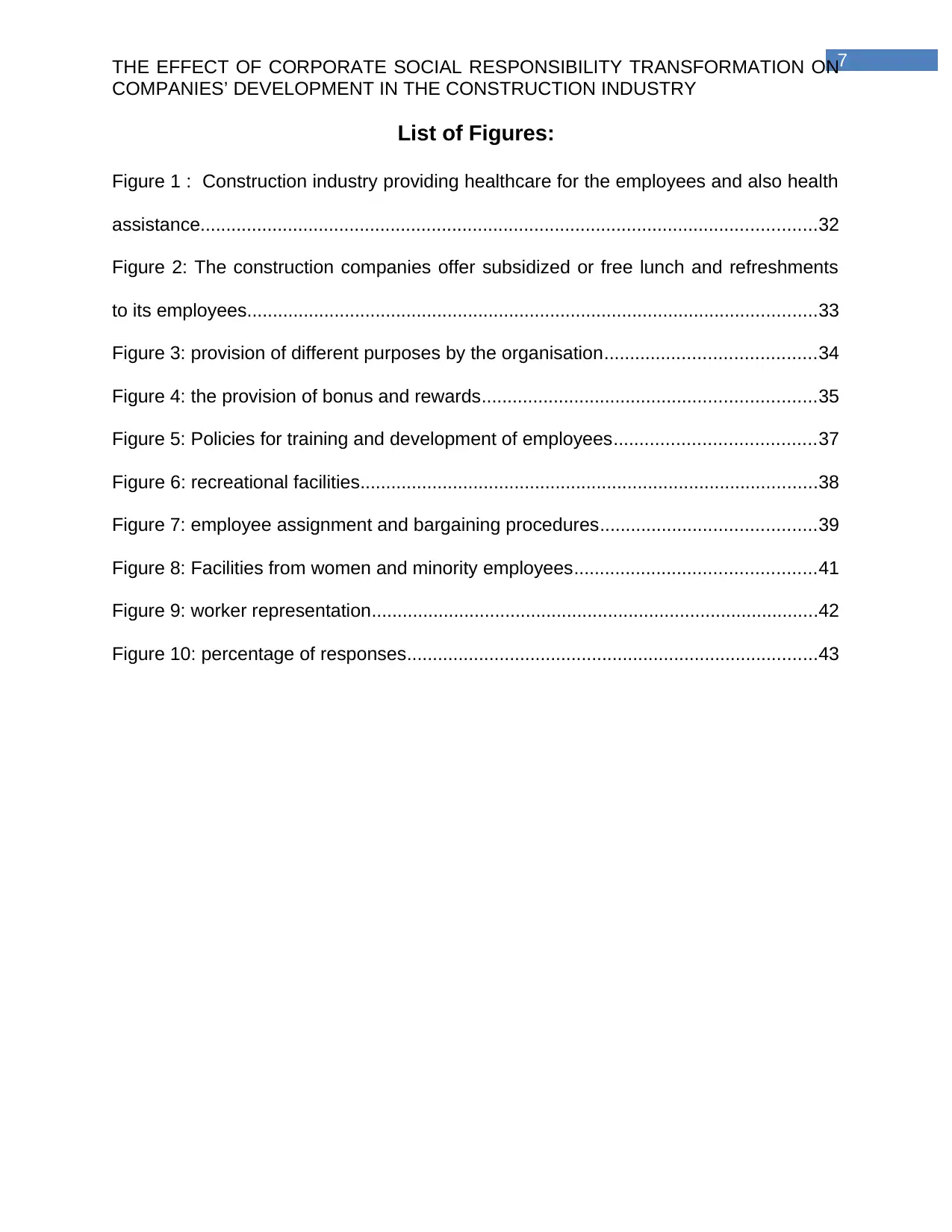
7THE EFFECT OF CORPORATE SOCIAL RESPONSIBILITY TRANSFORMATION ON
COMPANIES’ DEVELOPMENT IN THE CONSTRUCTION INDUSTRY
List of Figures:
Figure 1 : Construction industry providing healthcare for the employees and also health
assistance........................................................................................................................32
Figure 2: The construction companies offer subsidized or free lunch and refreshments
to its employees...............................................................................................................33
Figure 3: provision of different purposes by the organisation.........................................34
Figure 4: the provision of bonus and rewards.................................................................35
Figure 5: Policies for training and development of employees.......................................37
Figure 6: recreational facilities.........................................................................................38
Figure 7: employee assignment and bargaining procedures..........................................39
Figure 8: Facilities from women and minority employees...............................................41
Figure 9: worker representation.......................................................................................42
Figure 10: percentage of responses................................................................................43
COMPANIES’ DEVELOPMENT IN THE CONSTRUCTION INDUSTRY
List of Figures:
Figure 1 : Construction industry providing healthcare for the employees and also health
assistance........................................................................................................................32
Figure 2: The construction companies offer subsidized or free lunch and refreshments
to its employees...............................................................................................................33
Figure 3: provision of different purposes by the organisation.........................................34
Figure 4: the provision of bonus and rewards.................................................................35
Figure 5: Policies for training and development of employees.......................................37
Figure 6: recreational facilities.........................................................................................38
Figure 7: employee assignment and bargaining procedures..........................................39
Figure 8: Facilities from women and minority employees...............................................41
Figure 9: worker representation.......................................................................................42
Figure 10: percentage of responses................................................................................43
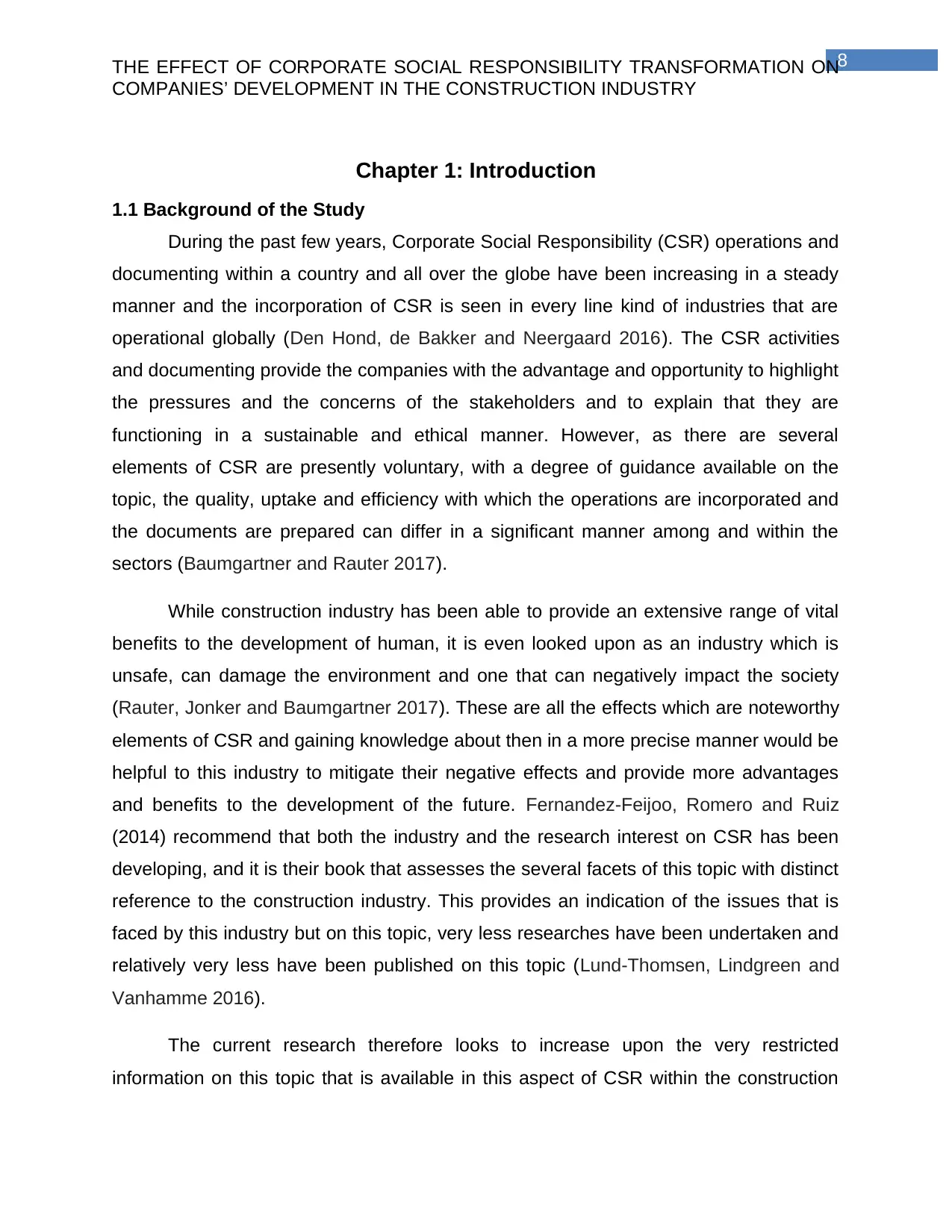
8THE EFFECT OF CORPORATE SOCIAL RESPONSIBILITY TRANSFORMATION ON
COMPANIES’ DEVELOPMENT IN THE CONSTRUCTION INDUSTRY
Chapter 1: Introduction
1.1 Background of the Study
During the past few years, Corporate Social Responsibility (CSR) operations and
documenting within a country and all over the globe have been increasing in a steady
manner and the incorporation of CSR is seen in every line kind of industries that are
operational globally (Den Hond, de Bakker and Neergaard 2016). The CSR activities
and documenting provide the companies with the advantage and opportunity to highlight
the pressures and the concerns of the stakeholders and to explain that they are
functioning in a sustainable and ethical manner. However, as there are several
elements of CSR are presently voluntary, with a degree of guidance available on the
topic, the quality, uptake and efficiency with which the operations are incorporated and
the documents are prepared can differ in a significant manner among and within the
sectors (Baumgartner and Rauter 2017).
While construction industry has been able to provide an extensive range of vital
benefits to the development of human, it is even looked upon as an industry which is
unsafe, can damage the environment and one that can negatively impact the society
(Rauter, Jonker and Baumgartner 2017). These are all the effects which are noteworthy
elements of CSR and gaining knowledge about then in a more precise manner would be
helpful to this industry to mitigate their negative effects and provide more advantages
and benefits to the development of the future. Fernandez-Feijoo, Romero and Ruiz
(2014) recommend that both the industry and the research interest on CSR has been
developing, and it is their book that assesses the several facets of this topic with distinct
reference to the construction industry. This provides an indication of the issues that is
faced by this industry but on this topic, very less researches have been undertaken and
relatively very less have been published on this topic (Lund-Thomsen, Lindgreen and
Vanhamme 2016).
The current research therefore looks to increase upon the very restricted
information on this topic that is available in this aspect of CSR within the construction
COMPANIES’ DEVELOPMENT IN THE CONSTRUCTION INDUSTRY
Chapter 1: Introduction
1.1 Background of the Study
During the past few years, Corporate Social Responsibility (CSR) operations and
documenting within a country and all over the globe have been increasing in a steady
manner and the incorporation of CSR is seen in every line kind of industries that are
operational globally (Den Hond, de Bakker and Neergaard 2016). The CSR activities
and documenting provide the companies with the advantage and opportunity to highlight
the pressures and the concerns of the stakeholders and to explain that they are
functioning in a sustainable and ethical manner. However, as there are several
elements of CSR are presently voluntary, with a degree of guidance available on the
topic, the quality, uptake and efficiency with which the operations are incorporated and
the documents are prepared can differ in a significant manner among and within the
sectors (Baumgartner and Rauter 2017).
While construction industry has been able to provide an extensive range of vital
benefits to the development of human, it is even looked upon as an industry which is
unsafe, can damage the environment and one that can negatively impact the society
(Rauter, Jonker and Baumgartner 2017). These are all the effects which are noteworthy
elements of CSR and gaining knowledge about then in a more precise manner would be
helpful to this industry to mitigate their negative effects and provide more advantages
and benefits to the development of the future. Fernandez-Feijoo, Romero and Ruiz
(2014) recommend that both the industry and the research interest on CSR has been
developing, and it is their book that assesses the several facets of this topic with distinct
reference to the construction industry. This provides an indication of the issues that is
faced by this industry but on this topic, very less researches have been undertaken and
relatively very less have been published on this topic (Lund-Thomsen, Lindgreen and
Vanhamme 2016).
The current research therefore looks to increase upon the very restricted
information on this topic that is available in this aspect of CSR within the construction
⊘ This is a preview!⊘
Do you want full access?
Subscribe today to unlock all pages.

Trusted by 1+ million students worldwide
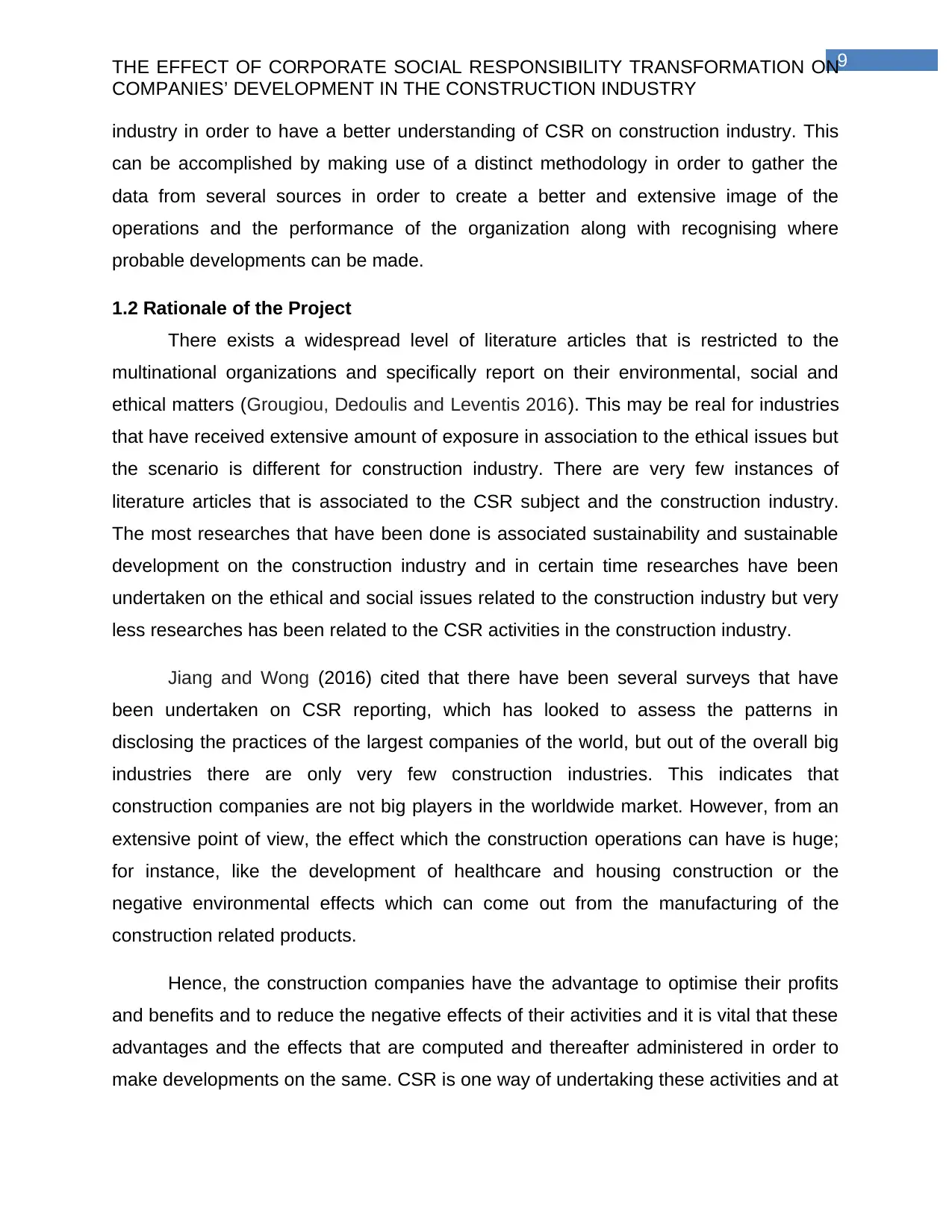
9THE EFFECT OF CORPORATE SOCIAL RESPONSIBILITY TRANSFORMATION ON
COMPANIES’ DEVELOPMENT IN THE CONSTRUCTION INDUSTRY
industry in order to have a better understanding of CSR on construction industry. This
can be accomplished by making use of a distinct methodology in order to gather the
data from several sources in order to create a better and extensive image of the
operations and the performance of the organization along with recognising where
probable developments can be made.
1.2 Rationale of the Project
There exists a widespread level of literature articles that is restricted to the
multinational organizations and specifically report on their environmental, social and
ethical matters (Grougiou, Dedoulis and Leventis 2016). This may be real for industries
that have received extensive amount of exposure in association to the ethical issues but
the scenario is different for construction industry. There are very few instances of
literature articles that is associated to the CSR subject and the construction industry.
The most researches that have been done is associated sustainability and sustainable
development on the construction industry and in certain time researches have been
undertaken on the ethical and social issues related to the construction industry but very
less researches has been related to the CSR activities in the construction industry.
Jiang and Wong (2016) cited that there have been several surveys that have
been undertaken on CSR reporting, which has looked to assess the patterns in
disclosing the practices of the largest companies of the world, but out of the overall big
industries there are only very few construction industries. This indicates that
construction companies are not big players in the worldwide market. However, from an
extensive point of view, the effect which the construction operations can have is huge;
for instance, like the development of healthcare and housing construction or the
negative environmental effects which can come out from the manufacturing of the
construction related products.
Hence, the construction companies have the advantage to optimise their profits
and benefits and to reduce the negative effects of their activities and it is vital that these
advantages and the effects that are computed and thereafter administered in order to
make developments on the same. CSR is one way of undertaking these activities and at
COMPANIES’ DEVELOPMENT IN THE CONSTRUCTION INDUSTRY
industry in order to have a better understanding of CSR on construction industry. This
can be accomplished by making use of a distinct methodology in order to gather the
data from several sources in order to create a better and extensive image of the
operations and the performance of the organization along with recognising where
probable developments can be made.
1.2 Rationale of the Project
There exists a widespread level of literature articles that is restricted to the
multinational organizations and specifically report on their environmental, social and
ethical matters (Grougiou, Dedoulis and Leventis 2016). This may be real for industries
that have received extensive amount of exposure in association to the ethical issues but
the scenario is different for construction industry. There are very few instances of
literature articles that is associated to the CSR subject and the construction industry.
The most researches that have been done is associated sustainability and sustainable
development on the construction industry and in certain time researches have been
undertaken on the ethical and social issues related to the construction industry but very
less researches has been related to the CSR activities in the construction industry.
Jiang and Wong (2016) cited that there have been several surveys that have
been undertaken on CSR reporting, which has looked to assess the patterns in
disclosing the practices of the largest companies of the world, but out of the overall big
industries there are only very few construction industries. This indicates that
construction companies are not big players in the worldwide market. However, from an
extensive point of view, the effect which the construction operations can have is huge;
for instance, like the development of healthcare and housing construction or the
negative environmental effects which can come out from the manufacturing of the
construction related products.
Hence, the construction companies have the advantage to optimise their profits
and benefits and to reduce the negative effects of their activities and it is vital that these
advantages and the effects that are computed and thereafter administered in order to
make developments on the same. CSR is one way of undertaking these activities and at
Paraphrase This Document
Need a fresh take? Get an instant paraphrase of this document with our AI Paraphraser
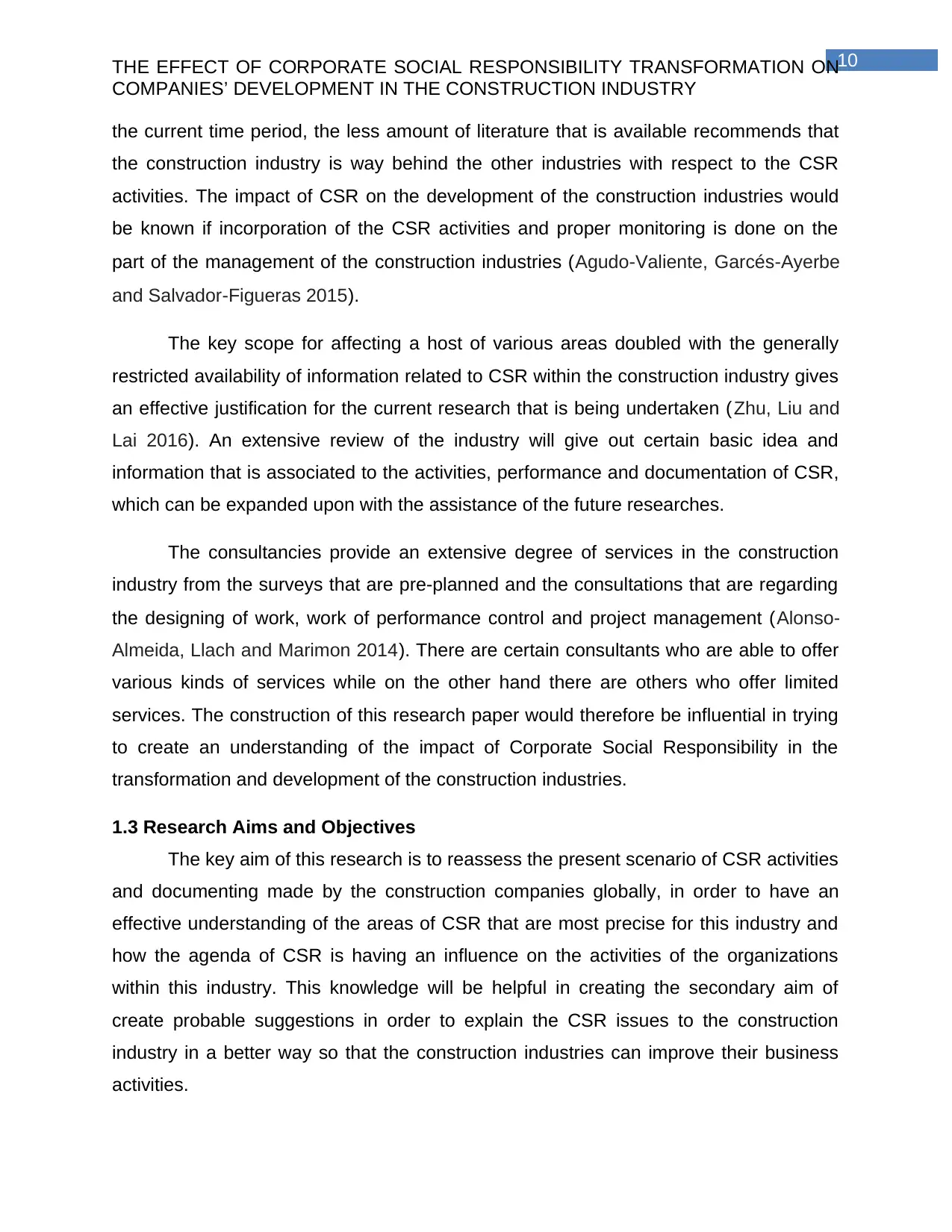
10THE EFFECT OF CORPORATE SOCIAL RESPONSIBILITY TRANSFORMATION ON
COMPANIES’ DEVELOPMENT IN THE CONSTRUCTION INDUSTRY
the current time period, the less amount of literature that is available recommends that
the construction industry is way behind the other industries with respect to the CSR
activities. The impact of CSR on the development of the construction industries would
be known if incorporation of the CSR activities and proper monitoring is done on the
part of the management of the construction industries (Agudo‐Valiente, Garcés‐Ayerbe
and Salvador‐Figueras 2015).
The key scope for affecting a host of various areas doubled with the generally
restricted availability of information related to CSR within the construction industry gives
an effective justification for the current research that is being undertaken (Zhu, Liu and
Lai 2016). An extensive review of the industry will give out certain basic idea and
information that is associated to the activities, performance and documentation of CSR,
which can be expanded upon with the assistance of the future researches.
The consultancies provide an extensive degree of services in the construction
industry from the surveys that are pre-planned and the consultations that are regarding
the designing of work, work of performance control and project management (Alonso‐
Almeida, Llach and Marimon 2014). There are certain consultants who are able to offer
various kinds of services while on the other hand there are others who offer limited
services. The construction of this research paper would therefore be influential in trying
to create an understanding of the impact of Corporate Social Responsibility in the
transformation and development of the construction industries.
1.3 Research Aims and Objectives
The key aim of this research is to reassess the present scenario of CSR activities
and documenting made by the construction companies globally, in order to have an
effective understanding of the areas of CSR that are most precise for this industry and
how the agenda of CSR is having an influence on the activities of the organizations
within this industry. This knowledge will be helpful in creating the secondary aim of
create probable suggestions in order to explain the CSR issues to the construction
industry in a better way so that the construction industries can improve their business
activities.
COMPANIES’ DEVELOPMENT IN THE CONSTRUCTION INDUSTRY
the current time period, the less amount of literature that is available recommends that
the construction industry is way behind the other industries with respect to the CSR
activities. The impact of CSR on the development of the construction industries would
be known if incorporation of the CSR activities and proper monitoring is done on the
part of the management of the construction industries (Agudo‐Valiente, Garcés‐Ayerbe
and Salvador‐Figueras 2015).
The key scope for affecting a host of various areas doubled with the generally
restricted availability of information related to CSR within the construction industry gives
an effective justification for the current research that is being undertaken (Zhu, Liu and
Lai 2016). An extensive review of the industry will give out certain basic idea and
information that is associated to the activities, performance and documentation of CSR,
which can be expanded upon with the assistance of the future researches.
The consultancies provide an extensive degree of services in the construction
industry from the surveys that are pre-planned and the consultations that are regarding
the designing of work, work of performance control and project management (Alonso‐
Almeida, Llach and Marimon 2014). There are certain consultants who are able to offer
various kinds of services while on the other hand there are others who offer limited
services. The construction of this research paper would therefore be influential in trying
to create an understanding of the impact of Corporate Social Responsibility in the
transformation and development of the construction industries.
1.3 Research Aims and Objectives
The key aim of this research is to reassess the present scenario of CSR activities
and documenting made by the construction companies globally, in order to have an
effective understanding of the areas of CSR that are most precise for this industry and
how the agenda of CSR is having an influence on the activities of the organizations
within this industry. This knowledge will be helpful in creating the secondary aim of
create probable suggestions in order to explain the CSR issues to the construction
industry in a better way so that the construction industries can improve their business
activities.
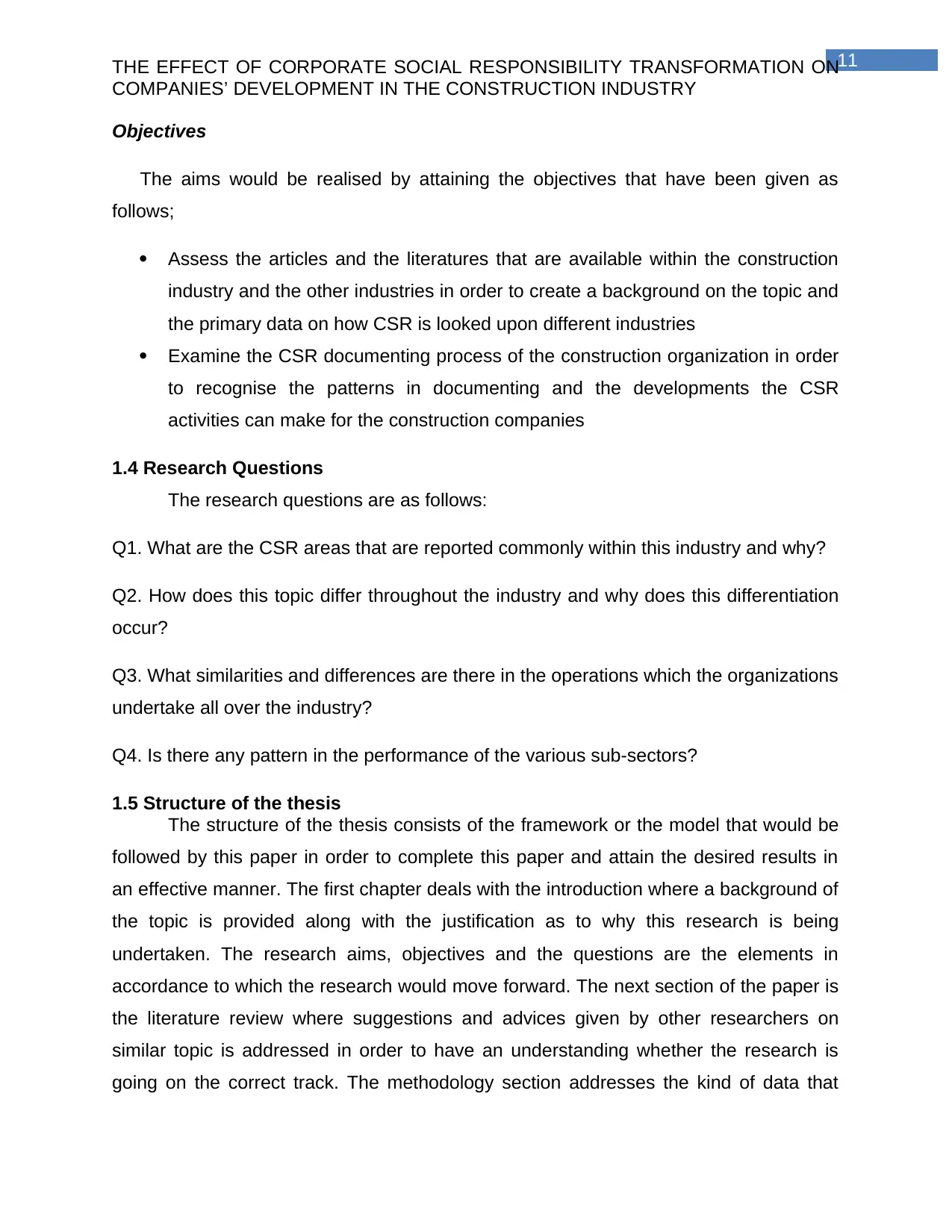
11THE EFFECT OF CORPORATE SOCIAL RESPONSIBILITY TRANSFORMATION ON
COMPANIES’ DEVELOPMENT IN THE CONSTRUCTION INDUSTRY
Objectives
The aims would be realised by attaining the objectives that have been given as
follows;
Assess the articles and the literatures that are available within the construction
industry and the other industries in order to create a background on the topic and
the primary data on how CSR is looked upon different industries
Examine the CSR documenting process of the construction organization in order
to recognise the patterns in documenting and the developments the CSR
activities can make for the construction companies
1.4 Research Questions
The research questions are as follows:
Q1. What are the CSR areas that are reported commonly within this industry and why?
Q2. How does this topic differ throughout the industry and why does this differentiation
occur?
Q3. What similarities and differences are there in the operations which the organizations
undertake all over the industry?
Q4. Is there any pattern in the performance of the various sub-sectors?
1.5 Structure of the thesis
The structure of the thesis consists of the framework or the model that would be
followed by this paper in order to complete this paper and attain the desired results in
an effective manner. The first chapter deals with the introduction where a background of
the topic is provided along with the justification as to why this research is being
undertaken. The research aims, objectives and the questions are the elements in
accordance to which the research would move forward. The next section of the paper is
the literature review where suggestions and advices given by other researchers on
similar topic is addressed in order to have an understanding whether the research is
going on the correct track. The methodology section addresses the kind of data that
COMPANIES’ DEVELOPMENT IN THE CONSTRUCTION INDUSTRY
Objectives
The aims would be realised by attaining the objectives that have been given as
follows;
Assess the articles and the literatures that are available within the construction
industry and the other industries in order to create a background on the topic and
the primary data on how CSR is looked upon different industries
Examine the CSR documenting process of the construction organization in order
to recognise the patterns in documenting and the developments the CSR
activities can make for the construction companies
1.4 Research Questions
The research questions are as follows:
Q1. What are the CSR areas that are reported commonly within this industry and why?
Q2. How does this topic differ throughout the industry and why does this differentiation
occur?
Q3. What similarities and differences are there in the operations which the organizations
undertake all over the industry?
Q4. Is there any pattern in the performance of the various sub-sectors?
1.5 Structure of the thesis
The structure of the thesis consists of the framework or the model that would be
followed by this paper in order to complete this paper and attain the desired results in
an effective manner. The first chapter deals with the introduction where a background of
the topic is provided along with the justification as to why this research is being
undertaken. The research aims, objectives and the questions are the elements in
accordance to which the research would move forward. The next section of the paper is
the literature review where suggestions and advices given by other researchers on
similar topic is addressed in order to have an understanding whether the research is
going on the correct track. The methodology section addresses the kind of data that
⊘ This is a preview!⊘
Do you want full access?
Subscribe today to unlock all pages.

Trusted by 1+ million students worldwide
1 out of 62
Related Documents
Your All-in-One AI-Powered Toolkit for Academic Success.
+13062052269
info@desklib.com
Available 24*7 on WhatsApp / Email
![[object Object]](/_next/static/media/star-bottom.7253800d.svg)
Unlock your academic potential
Copyright © 2020–2025 A2Z Services. All Rights Reserved. Developed and managed by ZUCOL.





